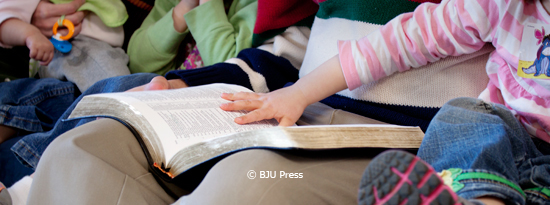
At times the challenge of developing a biblical worldview in my three little girls, five and under, overwhelms me. How can I equip these young minds with something as complex as a worldview? The writings of Paul David Tripp encourage me. In particular, Paul’s simple explanations and illustrations demonstrate that I can develop my daughters’ worldview.
I love Paul’s story about his three-year-old son, who after falling down the stairs exclaimed, “Thank you!” When Paul asked his son who he was talking to, the boy responded, “The angels. And I know how they did it.”
“Who did what?”
“The angels! One stands on this side, and the other stands on that side. They both hold beach balls. When you start to fall, they put the beach ball out to keep you safe.”
Tripp observes that even three-year-olds interpret what’s happening. In this case, the conclusion was immature, and it confused Sunday school lessons with family vacations. But even very young children are capable of understanding stories, synthesizing them, and using them to explain daily occurrences.
Thankfully, our heavenly Father has given us His perspective in terms of a story. It’s a story that even toddlers and preschoolers can learn and use to interpret everyday life. It’s a true story with a beginning, middle, and end. It’s a story that dramatically affects the way we interpret the learning that makes up education. It’s the story of Creation, Fall, and Redemption.
Creation
The story begins with “God created the heaven and the earth” (Genesis 1:1). But when the story reaches Genesis 1:26–28, we learn that we’re special. God creates man and woman in His own image. God tells them to fill the world with little image-bearers and to take care of the world. Then He gives the first man a home (Eden), a wife (Eve), and a job (to name the animals and to work the garden).
Fall
Then Adam rebels and everything breaks. Death, sadness, and fighting come because of Adam’s wrong choice. His sin means that our hearts have been broken and our minds have been polluted. Adam and Eve make clothes out of fig leaves and then hide from God. Adam blames his wife for the sin, and Eve blames the serpent (Genesis 3:7–12).
Redemption
Next, we see that God immediately sets in motion His plan to redeem His fallen creation (Genesis 3:15). He promises that there will be conflict between the anointed one and the serpent. He promises that the anointed one will win and redeem God’s creation. This redemption plan is fulfilled in Christ’s death on the cross, His burial, and His resurrection from the dead.
The story applied to . . . math?
I share this story, not because it’s new or insightful, but because it’s simple and familiar. This is a story I share with my girls during family devotions. It’s a story they hear in Sunday school, and it affects the way they interpret learning, even math!
- Math is a powerful tool to help us take care of the world (Genesis 1:28)
- Because of the fall, some people use math to deny God (Romans 1:21–23)
- The people of God can live in light of redemption by using math to love their neighbors (Luke 10:27–28)
The Creation-Fall-Redemption story doesn’t make worldview shaping easy, but it does make it attainable for my precious little ones. Using this story to interpret learning is critical for providing my children a thoroughly Christian education.



